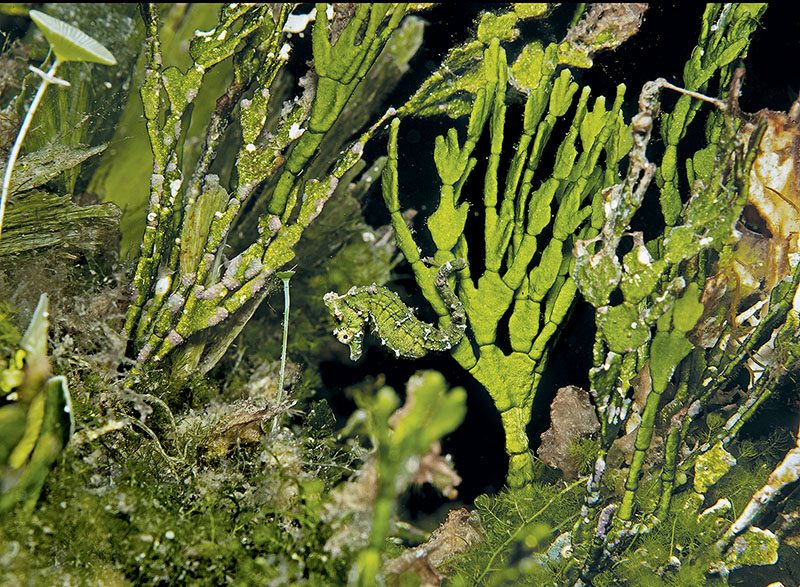NOTRE RÉCENTE AVENTURE SOUS-MARINE a commencé par une quête fantaisiste d'un petit poisson discret, pas plus grand qu'une pièce de cinq cents. À bien des égards, notre mini-mission à la recherche de l'hippocampe nain (Hippocampus zosterae) ressemblait plus à un week-end de jeunes insouciants qu'à un groupe de sept hommes et femmes enfilant des combinaisons de plongée le long du rivage en dur de la baie de Floride, rarement explorée, à Key Largo, en Floride.
Nous avons lancé la chasse à l'hippocampe nain deux ans plus tôt autour de la table à manger d'un ami de longue date, Richard Smith, PhD, dans les Cotswolds, en Angleterre. Lors de notre visite, il a évoqué les origines de sa passion pour l'observation de toutes les espèces d'hippocampes miniatures dans la nature.
His endeavor began soon after submitting his doctoral thesis in 2010 on the biology and conservation of gorgonian-associated pygmy seahorses. Over the ensuing years he extensively prospected Asian Pacific, Indian Ocean, and Red Sea waters to fulfill his dream. Along the way Smith coauthored two descriptive papers on recently discovered pygmy species from Japan and South Africa, and he was named a member of the International Union for Conservation of Nature’s Species Survival Commission Seahorse, Pipefish, and Seadragon Specialist Group.

Our afternoon chat soon switched to his recent invitation to speak at REEF Fest in Key Largo. The opportunity to share his wealth of seahorse stories with a gathering of like-minded fish enthusiasts happened to convene enticingly close to the historical population center of the dwarf seahorse’s home range. So, without hesitation, he jumped at the offer. The business of sorting out the logistics of our expedition, as usual, fell to Anna.
Unfortunately, her planning wasn’t rushed. The Reef Environmental Education Foundation (REEF) canceled the 2020 event due to COVID-19, and Smith could not fly to the U.S. the following year. In the interim Anna contacted marine life photographers from South Florida for some ideas on where to begin the hunt. In the end she located only two people with images, both of whom had found their dwarfs in seagrass meadows off a bayside park in the Middle Keys. The surprising shortage of photographs of such an intriguing species left the impression that the diminutive seahorse must be rare and endangered.
Une stratégie que nous avions tous en commun était d'avancer lentement ou de ne pas avancer du tout.
After a bit of sleuthing, Anna discovered that the aquarium trade annually removes large numbers of dwarf seahorses, many more are taken as bycatch during bait-shrimp trawling operations, and seagrasses — the species’ prime habitat — have experienced substantial die-offs. Despite all these setbacks, a 2019 analysis shows that population numbers in Florida Bay have stabilized or possibly increased and are estimated to number in the low millions.
Ces petites merveilles ne sont pas rares du tout. Elles habitent généralement des baies et des lagons peu attrayants et peu visibles que les plongeurs visitent rarement et qui sont difficiles à trouver, même lorsqu'on les cherche.
On the October morning after the 2022 REEF Fest finale — two and a half years after the idea’s inception — our dream team of seven experienced fish watchers, including four with PhD credentials in marine science, waded out into Florida Bay from the shoreline of a Key Largo dive resort. Although hope ran high, we each harbored doubts about finding our thumbnail-sized targets designed by nature to survive by stealth. Once beneath the surface, we quickly broke rank, fanning out across a 6-foot-deep sea of grass like foxhounds with their noses to the ground, each diver guided by respective instincts and strategies fashioned over years of underwater hunting.
One strategy we all had in common was moving slowly or not much at all. I explored the tangles of seagrass that fringe bare sand patches, squinting from one blade to the next, constantly looking for the motionless phantoms holding fast with long prehensile tails. But search as I might, after 45 minutes no sign of a seahorse — dwarf or otherwise — had appeared.
Distrait, j'ai nagé jusqu'à la paroi calcaire accidentée du rivage, où je me suis retrouvé à l'improviste dans un jardin d'algues exquis, recouvrant les rochers et les crevasses d'une délicieuse tapisserie de verdure. Alors que je me disais que la mer ne cessait de m'étonner, j'ai repéré un petit bout de peau niché dans une touffe d'algues en contrebas.
It was Smith’s seahorse, the only one we found that day, but one was all we needed. And we wouldn’t have been happier if it had been gilded in gold. We had accomplished our miniature mission, but the fun had just begun.
Le lendemain matin, armés d'une image de recherche et d'une meilleure idée de l'endroit où chasser, nous nous sommes rendus dans un petit parc côtier situé à 800 mètres en amont de la route nationale 1 et nous nous sommes dirigés directement vers le mur sous-marin caché par une féerie de verdure similaire. En 20 minutes, Smith et Anna ont repéré une demi-douzaine de nains sur une bande de 40 pieds.
Parmi le nombre, un mâle enceinte présentait une poche à couvain bombée débordant d'une progéniture en cours de maturation, tandis que sa charmante compagne vert émeraude se cachait à proximité avec une nouvelle réserve d'œufs prêts à fournir une nouvelle génération d'hippocampes à d'autres plongeurs chanceux. AD
© Alert Diver - Q2 2023